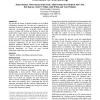ISCI
2002
14 years 5 months ago
2002
Tangible Interfaces for Collaborative Learning Environments (TICLE) explores new ways that multimedia can enhance education without becoming the focus of the educational experienc...
GRAPHICSINTERFACE
2003
14 years 7 months ago
2003
Many training, education, and visualization environments would benefit from realistic animated characters. Unfortunately, interfaces for character motion specification are often c...
ACMIDC
2008
14 years 7 months ago
2008
In this paper we describe the design and initial evaluation of a tangible computer programming exhibit for children on display at the Boston Museum of Science. We also discuss fiv...
CSCW
1998
ACM
14 years 10 months ago
1998
ACM
Current systems for real-time distributed CSCW are largely rooted in traditional GUI-based groupware and voice/video conferencing methodologies. In these approaches, interactions ...
CHI
1999
ACM
14 years 10 months ago
1999
ACM
We present TouchCounters, an integrated system of electronic modules, physical storage containers, and shelving surfaces for the support of collaborative physical work. Through ph...
ACMDIS
2000
ACM
14 years 10 months ago
2000
ACM
: Expanding the functionality of a successful system is always a challenge; the initial simplicity and ease-of-use is easily lost in the process. Experience indicates that this pro...
OZCHI
2009
ACM
14 years 10 months ago
2009
ACM
The design of Tangible Interfaces has already evolved since the first projects were developed. Frameworks and taxonomies have helped to understand the field of Tangible Interactio...
TEI
2009
ACM
15 years 14 days ago
2009
ACM
The majority of Tangible User Interfaces (TUIs) consist of rigid objects that are either held in the hands, or arranged relative to each other on a horizontal or vertical surface....
TEI
2010
ACM
15 years 15 days ago
2010
ACM
Collaborative pretend play is significant in the emotional and social development of young children yet traditional remote communication systems do not support this type of intera...
CHI
2001
ACM
15 years 6 months ago
2001
ACM
We describe the design of tangible interfaces to the KidPad collaborative drawing tool. Our aims are to support the reenactment of stories to audiences, and integration within rea...




